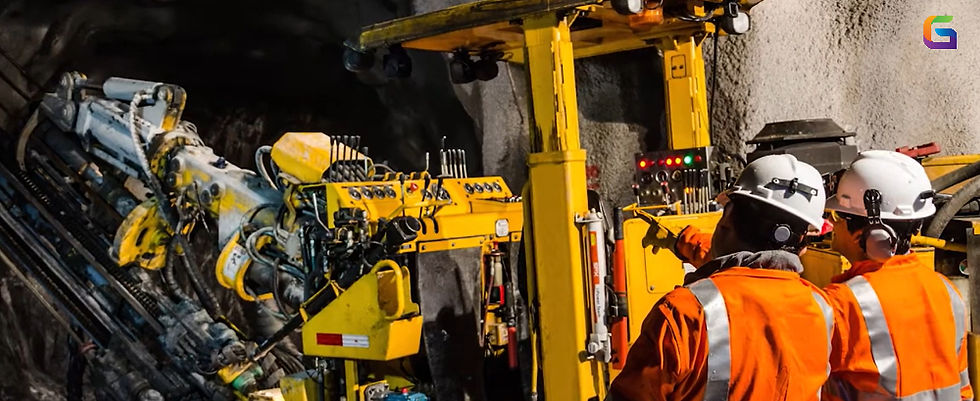Revolutionizing Mining Operations with AI and Machine Learning
- Anvita Shrivastava

- 17 hours ago
- 4 min read
In an industry that has always been reliant on human labour, traditional equipment, and historical data to inform operational decisions, the mining sector has been crucial to the development of industrial growth around the world. However, the implementation of Artificial Intelligence (AI) and Machine Learning (ML) is rapidly changing the way that the mining industry will operate, improving efficiencies, safety, and profitability. This technological transition is inevitable and more than a trend for companies seeking to compete in an increasingly data-driven world.

AI and ML for Mining: An Overview
AI refers to computational systems that can perform tasks conventionally associated with human intellect, such as making decisions, recognising patterns, and conducting predictive analysis. Machine Learning, which is a subset of AI, is used to enable systems to learn from data, identify patterns, and make predictions with minimal human evaluation.
Within the mining industry, AI and ML software are being deployed throughout the value chain--from exploration activities and extraction sites, to logistics and predictive maintenance--driving operational efficiency.
Predictive Maintenance and Equipment Optimisation
Mining operations depend on excavators, haul trucks, and conveyors as key components of the operation, and maintenance positively correlates to the availability of this equipment for production. However, typical maintenance schedules are often reactive, time-based frequency schedules where unexpected failures lead to downtime and losses to production.
AI-driven predictive maintenance deploys IoT sensors and machine learning algorithms that capture, assess, and interpret equipment health status in real-time. Activity sensors such as vibration, temperature, hydraulic pressure, and other operational parameters enable AI to:
Predict failures before they happen and notify operators.
Optimise maintenance schedules
Reduce unplanned downtime
Enhance equipment life
For example, a convolutional neural network (CNN) can study and analyse TIR sensor images and can predict micro-crack formation in key components of machinery, while recurrent neural networks (RNNs) can analyse temporal sensor data for predictive analytics.
AI-Driven Mineral Exploration
Mineral exploration is incredibly complicated and expensive, with historical success rates below 10%, especially for significant discoveries. The incorporation of machine learning also improves efficiencies by analysing meaningfully large datasets related to geological, geochemical and other factors.
Particularly, supervised machine learning algorithms, such as Random Forest and Gradient Boosting, categorise minerals based on specific geological signatures.
Unsupervised methods of machine learning also exist, such as K-Means clustering and DBSCAN, which identify unknown or hidden patterns and correlations in geological formations.
Deep learning models predict ore grades and reserve estimates much more accurately than conventional statistical models.
The insights gained through AI reduce mineral exploration costs, time to discovery, and resource estimates.
Autonomous Mining Operations
AI-powered autonomous systems are changing the way extraction and haulage of material is done. Self-driving haul trucks, automated drilling rigs, and robotic loaders, to name a few, are now capable of working in extreme or hazardous situations with minimum human interaction.
Machine-learning algorithms will constantly analyse terrain, traffic and environmental datasets to:
Optimise haul routes,
Optimise fuel consumption,
Enforce equipment wear optimisations, and
Enforce operational safety.
These autonomous machinery solutions will lead to lower labour costs, reduced human risk in hazardous conditions, and increased operational throughput.
AI Applications for Ore Grade Prediction and Processing Optimisation
Precise ore grade prediction is essential in optimising recovery rates while minimising processing costs. Machine learning (ML) algorithms mine historical sampling, drilling, and sensor data to forecast ore quality as it is produced.
Regression models can be developed to predict ore grade variability on site.
Reinforcement learning algorithms optimise processing parameters, including flotation, leaching, and smelting.
A vision or computer vision system can be used to accurately identify mineral types and unwanted impurities on conveyor belts, thereby improving downstream sorting.
Through integration with AI systems in mining processing plants, mining companies can potentially realise enhanced recovery rates while simultaneously minimising energy inputs and environmental impacts.
Safety and Risk Management
Mining is one of the most dangerous occupations on earth. Use of AI in the mining sector can be utilised to improve safety through predictive risk modelling, real-time monitoring, or enhanced emergency response systems.
Computer vision or object detection could be utilised for determining worker and machinery locations in no-go zones.
Predictive analytics could assist in detecting risk conditions for landslides, gas leakage, or equipment breakdowns.
Digital twins could be utilised to simulate mine operations for risk scenarios and adherence to appropriate safety protocols.
AI-facilitated safety systems can assist in mitigating accidents for mine workers and associated personnel while complying with regulatory standards.
Environmental Monitoring and Sustainability
There are increasing concerns around sustainability within the mining industry. AI and ML are playing an important role by tracking environmental impacts and improving resource efficiency.
Satellite images and ML algorithms are being used to find, track, and measure deforestation, tailings, and water contamination.
AI is measuring and optimising energy consumption, which reduces carbon footprints.
Predictive models contribute to efficient water management and waste management, ensuring necessary compliance with environmental regulations.
Mining operations can now be economically viable and purposefully responsible for environmental concerns.
Future Outlook
AI and ML are still early in their adoption in the mining sector, but their potential is significant. AI is ushering in a new era of smarter, safer, and more efficient mining, from predictive maintenance and autonomous operations to estimating ore grades and sustainability practices.
Mining companies that pursue AI-based strategies will command a new frontier of competitiveness through reduced costs, increased productivity, and fewer operational risks. As AI technology improves, mining will be transformed into a more data-driven decision-making business model in operations.
Artificial Intelligence and Machine Learning are no longer an option in modern mining; they are required tools that are changing the way the industry operates. Using AI-based predictive maintenance, autonomous machines, exploration analytics, grade prediction, and environmental monitoring, mining companies can achieve unparalleled efficiency, safety, and profitability.
For more information or any questions regarding AI and Machine Learning, please don't hesitate to contact us at
Email: info@geowgs84.com
USA (HQ): (720) 702–4849
(A GeoWGS84 Corp Company)




Comments